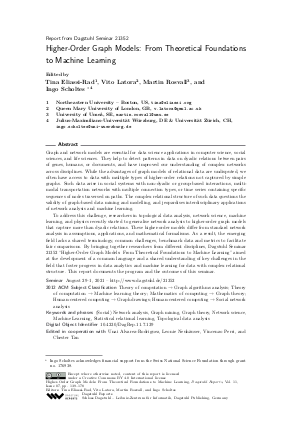Higher-Order Graph Models: From Theoretical Foundations to Machine Learning (Dagstuhl Seminar 21352)
Authors Tina Eliassi-Rad, Vito Latora, Martin Rosvall, Ingo Scholtes and all authors of the abstracts in this report
-
Part of:
Issue:
Dagstuhl Reports, Volume 11, Issue 7
Part of: Volume: Dagstuhl Reports, Volume 11
Part of: Journal: Dagstuhl Reports (DagRep) - License:
 Creative Commons Attribution 4.0 International license
Creative Commons Attribution 4.0 International license
- Publication Date: 2021-12-22
File

PDF
DagRep.11.7.139.pdf
- Filesize: 9.34 MB
- 40 pages
Document Identifiers
Subject Classification
ACM Subject Classification
- Theory of computation → Graph algorithms analysis
- Theory of computation → Machine learning theory
- Mathematics of computing → Graph theory
- Human-centered computing → Graph drawings
- Human-centered computing → Social network analysis
Keywords
- (Social) Network analysis
- Graph mining
- Graph theory
- Network science
- Machine Learning
- Statistical relational learning
- Topological data analysis
Metrics
- Access Statistics
-
Total Accesses (updated on a weekly basis)
0Document
0Metadata
Abstract
Graph and network models are essential for data science applications in computer science, social sciences, and life sciences. They help to detect patterns in data on dyadic relations between pairs of genes, humans, or documents, and have improved our understanding of complex networks across disciplines. While the advantages of graph models of relational data are undisputed, we often have access to data with multiple types of higher-order relations not captured by simple graphs. Such data arise in social systems with non-dyadic or group-based interactions, multi-modal transportation networks with multiple connection types, or time series containing specific sequences of nodes traversed on paths. The complex relational structure of such data questions the validity of graph-based data mining and modelling, and jeopardises interdisciplinary applications of network analysis and machine learning. To address this challenge, researchers in topological data analysis, network science, machine learning, and physics recently started to generalise network analysis to higher-order graph models that capture more than dyadic relations. These higher-order models differ from standard network analysis in assumptions, applications, and mathematical formalisms. As a result, the emerging field lacks a shared terminology, common challenges, benchmark data and metrics to facilitate fair comparisons. By bringing together researchers from different disciplines, Dagstuhl Seminar 21352 "Higher-Order Graph Models: From Theoretical Foundations to Machine Learning" aimed at the development of a common language and a shared understanding of key challenges in the field that foster progress in data analytics and machine learning for data with complex relational structure. This report documents the program and the outcomes of this seminar.
Cite As Get BibTex
Tina Eliassi-Rad, Vito Latora, Martin Rosvall, and Ingo Scholtes. Higher-Order Graph Models: From Theoretical Foundations to Machine Learning (Dagstuhl Seminar 21352). In Dagstuhl Reports, Volume 11, Issue 7, pp. 139-178, Schloss Dagstuhl – Leibniz-Zentrum für Informatik (2021)
https://doi.org/10.4230/DagRep.11.7.139
BibTex
@Article{eliassirad_et_al:DagRep.11.7.139,
author = {Eliassi-Rad, Tina and Latora, Vito and Rosvall, Martin and Scholtes, Ingo},
title = {{Higher-Order Graph Models: From Theoretical Foundations to Machine Learning (Dagstuhl Seminar 21352)}},
pages = {139--178},
journal = {Dagstuhl Reports},
ISSN = {2192-5283},
year = {2021},
volume = {11},
number = {7},
editor = {Eliassi-Rad, Tina and Latora, Vito and Rosvall, Martin and Scholtes, Ingo},
publisher = {Schloss Dagstuhl -- Leibniz-Zentrum f{\"u}r Informatik},
address = {Dagstuhl, Germany},
URL = {https://drops.dagstuhl.de/entities/document/10.4230/DagRep.11.7.139},
URN = {urn:nbn:de:0030-drops-155929},
doi = {10.4230/DagRep.11.7.139},
annote = {Keywords: (Social) Network analysis, Graph mining, Graph theory, Network science, Machine Learning, Statistical relational learning, Topological data analysis}
}
